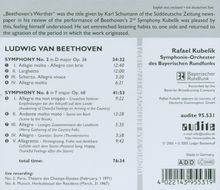Ludwig van Beethoven: Symphonien Nr.2 & 6 auf CD
Symphonien Nr.2 & 6
Herkömmliche CD, die mit allen CD-Playern und Computerlaufwerken, aber auch mit den meisten SACD- oder Multiplayern abspielbar ist.
(soweit verfügbar beim Lieferanten)
- Künstler:
- Symphonieorchester des Bayerischen Rundfunks, Rafael Kubelik
- Label:
- Audite
- Aufnahmejahr ca.:
- 1967/1971
- Artikelnummer:
- 2753780
- UPC/EAN:
- 4022143955319
- Erscheinungstermin:
- 1.2.2007
Beethoven hat sich von Anfang an als eigenständiger Komponist empfunden. Gleichwohl konnte er sich als junger Mann dem Einfluss der großen Wiener Meister nicht entziehen, da die Verbindlichkeit ihrer Werke und ihre Kongruenz mit dem Zeitgeist so selbstverständlich war, dass Beethoven gar nicht umhin kam, sich des gleichen musikalischen Vokabulars zu bedienen. Dennoch verwendete er diese Mittel von Anfang an in einer neuen Sprache, deren Neuartigkeit alle wachen Zuhörer von Anfang an begriffen und auf die sie mit Begeisterung oder Erschrecken reagierten. Die Entstehung der D-Dur Sinfonie fällt in eine Zeit der Verzweiflung Beethovens über die fortschreitende Ertaubung. Dennoch hemmten diese Gefühlsausbrüche weder seine schöpferische Energie, noch spiegeln sie sich im Charakter der damals entstandenen Werke. Ein Zeitgenosse über die zweite Sinfonie:"Sie ist ein merkwürdiges, kolossales Werk, von einer Tiefe, Kraft und Kunstgelehrsamkeit, wie sehr wenige." Die ungewöhnlich lange Einleitung, die gehäuften Dynamikwechsel im Scherzo und die orchestrale Virtuosität des Finales mit seinem geistreichen Humor spiegeln eben diese "Kunstgelehrsamkeit " In seiner sechsten Sinfonie setzt Beethoven andere Schwerpunkte. Der Titel "Pastoral-Sinfonie oder Erinnerungen an das Landleben" und die poesievollen Satzüberschriften scheinen auf den programmatischen Charakter der Sinfonie hinzuweisen dennoch schrieb Beethoven selbst: "Mehr Ausdruck der Empfindung als Malerei.", was dem klar widerspricht. Bei tieferem Eindringen in die Musik wird deutlich, dass sie durch sich selbst lebt die genauen Satzbezeichnungen sprechen eine allgemeine Befindlichkeit an, die allzu viele Deutungen ausschließen soll, die Musik bleibt auch ohne Kenntnis der Überschriften erlebbar. Die Pastoral-Sinfonie entspringt Beethovens großer Verbundenheit mit der Natur: Weit entfernt von der Naturschwärmerei der Romantik sah er in ihr das Individuum eingebunden in die göttliche Schöpfung des Kosmos. Wie in der Natur wird der Wechsel von Spannung und Entspannung in Beethovens sechster Sinfonie zum schöpferischen Akt. Die Live-Aufnahme der Sinfonie Nr. 2 entstand am 1.Februar 1971 im Théatre des Champs-Elysées, die Live-Aufnahme der Sinfonie Nr. 6 am 31.März 1967 im Herkulessaal der Münchner Residenz. In beiden Konzertmitschnitten musiziert das Symphonie-Orchester des Bayerischen Rundfunks unter der Leitung von Rafael Kubelik.
From the very beginning Beethoven considered himself to be an independent composer. As a young man, however, he could not avoid the influence of the great Viennese masters. Their works are so inextricably bound with the spirit of their age that Beethoven could not help but make use of their musical vocabulary. From the outset, nonetheless, he used these stylistic means to form a new musical language, a language immediately understood by all attentive listeners, who reacted either with enthusiasm or shock. The composition of the D-major Symphony coincides with the period of Beethoven's desperation over his impending deafness. But these emotional outbursts neither inhibited his creative energy nor are they reflected in the character of the works written during this time. A contemporary wrote about the Second Symphony as follows: "It is a strange, colossal work of a depth, power and artistic erudition that only few works have." The unusually long introduction, the frequent dynamic changes in the Scherzo and the orchestral virtuosity of the Finale with its witty humour do indeed reflect this "artistic erudition." Beethoven emphasises different qualities in his Sixth Symphony. The title "Pastoral Symphony or Reminiscences of Country Life" and the poetic headings of the movements seem to indicate the programmatic character of the Symphony, yet Beethoven himself wrote that it was "more an expression of feelings than tone-painting," thus clearly contradicting this initial impression. When delving more deeply into this music, it becomes apparent that it has its own life the exact movement designations refer to general conditions which would rule out too many specific interpretations. The music can indeed be experienced without knowledge of these titles. The Pastoral Symphony originated in Beethoven's profound communion with nature. Far from indulging in the nature-worship typical of the romantic period, he saw - in nature - the individual inextricably bound in the holy creation of the cosmos. As in nature, the alternation of tension and relaxation in Beethoven's Sixth Symphony becomes a creative act. This live recording of the Symphony No. 2 was made on 1 February 1971 at the Théâtre des Champs-Elysées the Symphony No. 6 was recorded live on 31 March 1967 in the Herkulessaal of the Munich Residenz. The Bavarian Radio Symphony Orchestra performs under Rafael Kubelik on both concert recordings.
Rezensionen
Audite a bien raison de poursuivre l'édition de documents relatifs à Rafael Kubelik. (www. classicstoday-france. com)
Disk 1 von 1 (CD)
Sinfonie Nr. 2 D-Dur op. 36
-
1 1. Adagio molto - Allegro con brio
-
2 2. Larghetto
-
3 3. Scherzo: Allegro vivace
-
4 4. Allegro molto
Sinfonie Nr. 6 F-Dur op. 68 "Pastorale"
-
5 1. Allegro ma non troppo
-
6 2. Andante molto moto
-
7 3. Allegro
-
8 4. Allegro
-
9 5. Allegretto
Mehr von Ludwig van Beet...
-
Ludwig van BeethovenDie Geschöpfe des Prometheus op.43CDVorheriger Preis EUR 7,99, reduziert um 0%Aktueller Preis: EUR 2,99
-
Ludwig van BeethovenMödlinger Tänze WoO 17 Nr.1-11CDAktueller Preis: EUR 7,99
-
Carl Heinrich ReineckeSämtliche Klaviertrios2 CDsAktueller Preis: EUR 14,99
-
Schuppanzigh Quartett - Beethoven / Ries / RodeCDAktueller Preis: EUR 14,99








